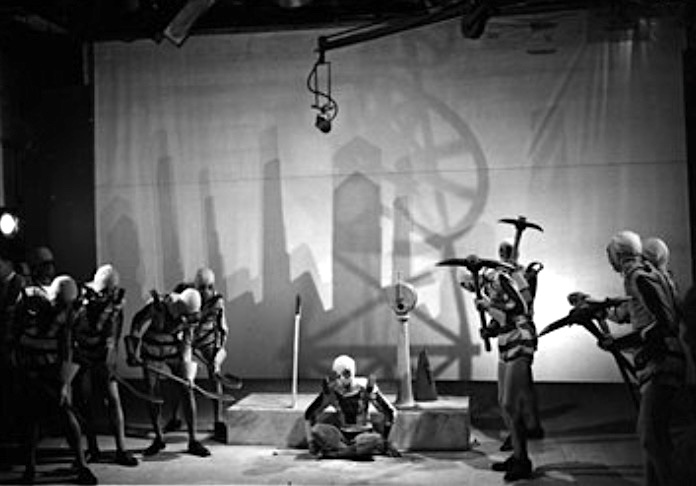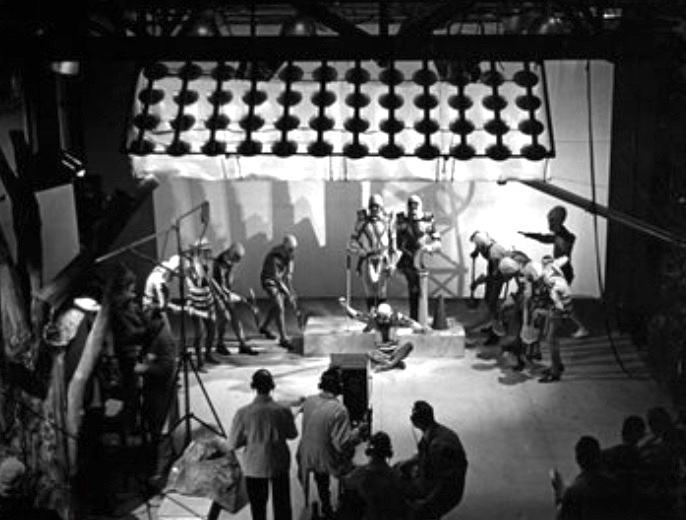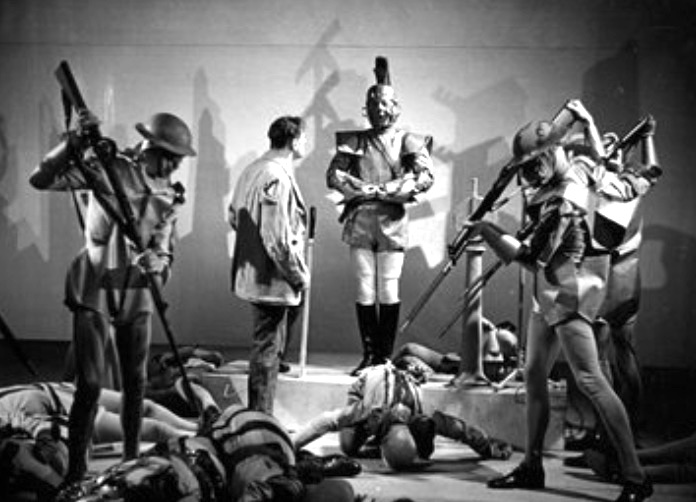OTD in early British television: 30 May 1939

John Wyver writes: On Tuesday 30 May 1939 viewers could watch Jan Bussell’s 87-minute production of Arnold Bennett’s drama The Great Adventure in the afternoon and then, presumably in the other studio, an 82-minute adaptation of the Czech writers Karel and Josef Čapek’s satire The Insect Play in the evening.
Malcolm Baker-Smith’s settings, which clearly made imaginative use of the shadow projection system known as the ‘penumbrascope’, can be seen in these production photographs, as can Hugh Stevenson‘s striking costumes. Stevenson was better-known as a costume designer for ballet, and he worked frequently with choreographers Antony Tudor and Andrée Howard, both AP regulars, and the latter of whom provided dances for The Insect Play.
Wikipedia offers this precis of the Čapek brothers’ eccentric play:
A tramp/narrator falls asleep in the woods and dreams of observing a range of insects that stand in for various human characteristics in terms of their lifestyle and morality: the flighty, vain butterfly, the obsequious, self-serving dung beetle, the ants, whose increasingly mechanized behaviour leads to a militaristic society. The anthropomorphized insects allow the writers to comment allegorically on life in post-World War I Czechoslovakia.
In the early 1920s The Insect Play, presented in a free adaptation by Paul Selver, had been a success at the Lyric, Hammersmith for producer Nigel Playfair and co-translator Clifford Bax. Moreover, Stephen Thomas, AP producer for The Insect Play, was the stage manager on the Lyric version, and Frederic Austin’s music composed for the show was used again for television. As a commentator pointed out, ‘in many ways the televised version was a reconstruction of Sir Nigel Playfair’s production in 1923.’

The Times provided a detailed review:
The insect world is seen as a microcosm of the human world and the behaviour of the insects bears a strong family likeness to the follies of mankind. First. we see the butterflies flitting about, beautiful opportunists, living a life of pleasure and leisure, entirely amoral. In the televised version, this scene was turned into a ballet and very little of the original scene remained.
Sequences followed with beetles and with a pair of crickets, played by Leslie French and Wendy Toye
whose performance was exactly suited to the new medium, and another good performance was given by Miss Pamela Standish as the Moth Chrysalis, who flutters out for one brief hour of life at the end of the play. Miss Andrée Howard’s charming choreography for the moth ballet here seemed entirely in place.

After this happy-go-lucky life among the grasses by the pool the Tramp, who is the one human being in the play, turns his attention to the organized life of the ant-heap, the worker-ants, the soldier-ants, the dictator-ants. And here clever use was made of shadows on a backcloth to give an impression of vast machinery in motion.

The most trenchant satire of the play lies in this scene, and it was well brought out… in a production which was at all times interesting and often arresting, and which deserves the two further performances which it is to receive.
As the review notes, and presumably because of the significant resources deployed, The Insect Play was given again twice in short order, which was rare for a pre-war drama, on Wednesday 7 June and Monday 12 June.
[OTD post no. 164; part of a long-running series leading up to the publication of my book Magic Rays of Light: The Early Years of Television in Britain in January 2026.]
I might well have complemented my post with words from Grace Wyndham Goldie in The Listener, which I am pleased to append (in part) here:
‘[I]n spite of the excellence of the acting, in spite of the beautifully built up pictorial effects, in spite of the triumphantly successful use of Mr. Baker Smith’s penumbrascope shadows on the backcloth in the ant scenes, in spite of the general magnificence of the production, the thing as a whole was often tedious in the extreme.
‘This was partly the play which is sixteen years old and so prophetic in its prediction of totalitarian argument that we seemed to be listening to emphatic repetitions of the statements we have been reading in our daily papers for the last three years. But the main reason for the tediousness of the play was quite different and for our purpose much more important. This is that it was slow.
‘Now to viewers this is a pressing matter for the disease of slowness is one which afflicts a vast quantity of television plays. It is, certainly, a perfectly natural result of the process of transferring a piece written for the stage on to the television screen.
‘The action, much of which is simultaneous in the theatre, is broken up into separate scenes to suit the cameras and is then presented in successive shots. This naturally slows everything up.
‘And I suggest that the most urgent general problem which faces the hard-driven producers of television plays is that of finding some methods which will counteract the prevailing lackof pace. And the producer of The Insect Play could have begun by cutting each of the not very relevant ballets to a quarter of their original length.’
You are too modest to link to your 2011 appraisal of the only other BBC Television production of The Insect Play (in 1960)!: https://screenplaystv.wordpress.com/2011/06/14/twentieth-century-theatre-the-insect-play-1960-bbc/ “I do think I’ve had enough televised insects for a while.”
Interesting that, as in 1939, the production was heavily resourced, using two studios.
Thanks, Billy. I meant to include some mention of the 1960 production, although I think that perhaps I found it so ridiculous (and so astonishing that it could have been given a major production as late as 1960) that I blanked it from my memory. I’m grateful for the prompt.
I was more surprised that you didn’t refer back to your piece on the previous 1938 Capek production, a natural companion piece – https://www.illuminationsmedia.co.uk/otd-in-early-british-television-11-february-1938/